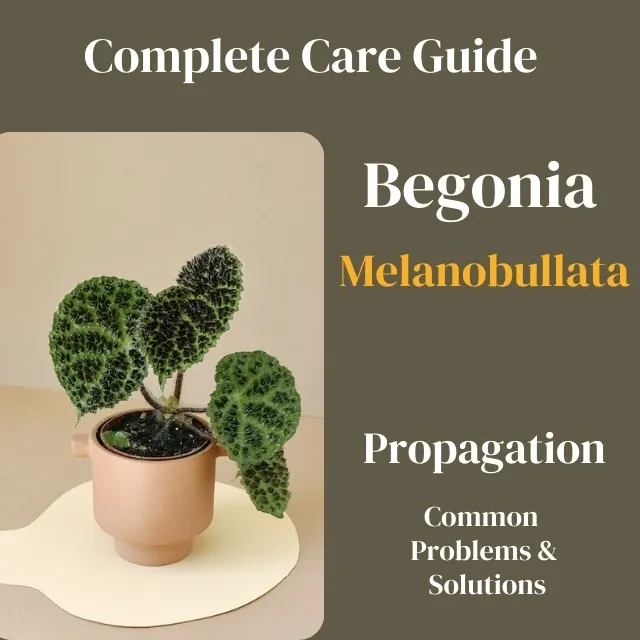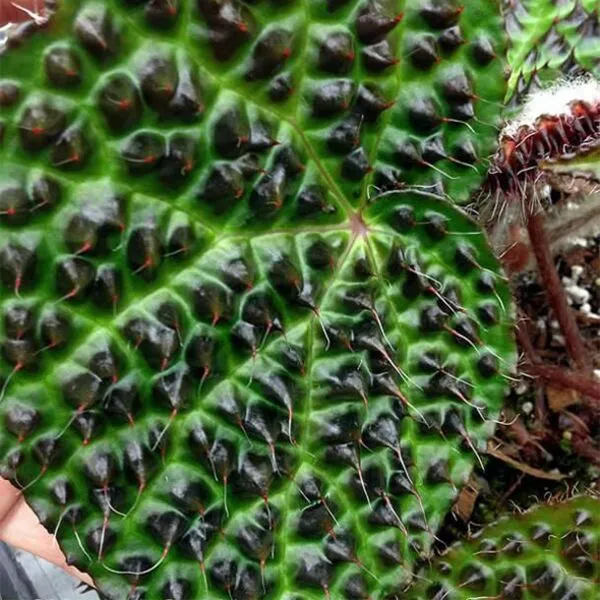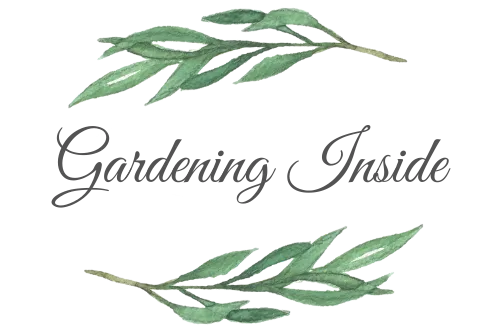Begonia Melanobullata is an exceptionally interesting species from the precipices of Vietnam. Begonia’s name refers to the very dark “bubbles or bubbles” of its leaves. Melanobullata is a tropical begonia that is popular for its leaves that have teeth-like spikes on them.
This species shows its unique dim-hued bullate from an exceptionally young age. Begonia Ferox is known as Begonia melanobullata’s doppelgänger .When Begonia Ferox reaches maturity, its green leaves will be decked with dark cones on the underside, just like the melanbullata.
Begonia melanobullata is a just now gaining ground, remarkable species. In its local environment, it is portrayed as being found sticking to limestone precipices and rock holes in conceal. This species requires high humidity to thrive.

Characteristics of Begonia Melanobullata
Begonia Melanobullata is a recently discovered type of blossoming plant in the Begoniaceae family. Begonia Melanobullata has fantastic foliage; the leaf shape is comprehensively elliptic and green in color. These plants can develop to be six to twelve inches. Begonia can grow both inside and outside.
| Scientific name | Begonia Melanobullata |
| Family | Begoniaceae |
| Genus | Begonia |
| Habitat | Northern Vietnam |
| Varieties of Begonia | 2000+ |
Step by Step Begonia Melanobullata Care guide
Begonia Melanbullata requires a specific environment to thrive. This section provides vital information to keep this plant happy and healthy.
Water Requirements
Water the plant when the top 2-3 cm of the soil becomes dry. The plant absorbs water from soil and atmosphere—water less in winters and more in summer.
In waterlogged soil, the roots will start to rot.
Light Requirements
Begonia Melanobullata requires low to medium indirect sunlight for best growth. The plant can take a little direct sunlight, but prolonged direct sunlight will harm the plant.
Humidity Requirements
Begonia Melanobullata loves humidity. The plant grows well in 75% -95% humid environment.
To increase humidity humidifier or pebble tray can be used.
Temperature Requirements
Begonia Melanobullata requires intermediate to warm temperature for its growth. The plant thrives in temperatures ranging from 20-25oC (70-80F).
Soil and Fertilizer Requirements
Begonia Melanobullata requires well-draining, slightly acidic with a pH of about 5.5. Potting mix for the best growth of begonia plant can be made by mixing two parts of peat moss, one part perlite, kanuma bonsai soil, one part vermiculite, and half part sphagnum moss.
Begonia Melanobullata can survive only on nutrients provided by healthy soil. The plant does not require fertilizer, but diluted fertilizer may be used if the growth is much slower. But do not fertilize during winters as this is the dormancy period of the plant.

Repotting Begonia Melanobullata
Begonia Melanobullata is a slow-growing plant and requires repotting every two to three years. Following tips should be taken into account before repotting.
- The plant should be repotted when it outgrows its pot.
- Early spring or winter season is best to report the plant.
- The new pot should be on size larger than the previous pot.
Also Read: Best Aglaonema Pictum Tricolor Care & Propagation Tips
How to propagate Begonia Melanobullata
Begonia Melanobullata can be easily propagated by stem cutting. Step by step guide to propagating the plant is as follows:
- Use a sterilized knife or garden shears to cut a few stems from the plant.
- Make sure the cuttings are healthy and not infected.
- Plant these cuttings in well-drained soil.
- Expose the new plant to minimum light and water thoroughly.
Within a few days, new roots will be established.
Also Read: How to Care for Calathea Medallion with Growth Tips
Begonia Melanobullata Common Problems and Solutions
Pests
Begonia Melanobullata is prone to Aphids, spider mites, whiteflies, and mealybugs.
These pests can cause critical plant harm like slowed development, drooping leaves, and plant death. They can likewise contaminate plants with diseases.
Pesticides can be used to get rid of these pests.
Leaf Spot
Leaf spot is a bacterial contamination that is normal among this species because the plant does not like being wet.
Yellow leaves of Begonia are indications of this disease.
To prevent your plant from dying, cut the infected portion of the plant and do not leave the plant in excessive water.
Powdery Mildew
Fungus attack on the plants’ leaves results in powdery mildew. The infected leaves appear to be covered with a white powdery substance. The leaves may also turn yellow and fall off.
To overcome this disease, fungicides should be used. However, starting treatment at the earliest opportunity before it spreads is essential.
Conclusion
Begonia melanobullata is a rare and unique species with spikes on its leaves. It is tough and easy to care for plants. Simply follow the care guide, and your Begonia will last long.
The way to keep steady over any issues that might emerge with this plant is to examine it consistently. The objective of doing so is to recognize problems immediately and address them before they create additional inconveniences.
Happy Gardening!!!
Frequently Asked Questions about Begonia Melanobullata
What is the rarest Begonia?
Begonia Melanobullata is a reare plant but Begonia crassicaulis is the rarest Begonia.
How tall begonia Melanobullata can grow?
Melanobullata can grow up to 15cm, but the plant grows 10cm tall in the plastic pot.
What Is The Difference Between Begonia Melanobullata Versus Begonia Ferox?
Begonia melanobullata develops its distinctive dark-colored bullate from a very early age, while the Begonia ferox needs to be more mature before development occurs.
Can Begonia Melanabullata Grow In Terrarium?
Yes, you can grow Begonia Melanabullata in a terrarium.
Can Begonia Melanabullata Grow In Sphagnum Moss?
Begonia Melanabullata fills best in a very much depleted, aerated soilless medium that holds dampness well. Sphagnum peat moss is an incredible developing media that holds water and supplements. If you add other soil revisions like perlite or treat the soil bark to the peat greenery, it will make the peat greenery channel and circulate air through more.
